
PIN
FUNCTION
PIN
FUNCTION
1
VDD
23
SCL
2
PD5
24
SDA
3
PD6
25
DACCOMP
4
PD7
26
RED/C
5
CLAMP
27
GREEN/Y
6
COMPSYNC
28
AVDD
7
PALID
29
AGND
8
SCSYNC
30
AVDD
9
REFSQ
31
BLUE/CVBS2
10
GND
32
CVBS1
11
VDD
33
VREF
12
FC2
34
RREF
13
FC1
35
AGND
14
FC0
36
AGND
15
HSYNC
37
AVDD
16
VSYNC
38
PD0
17
TTXREQ
39
PD1
18
SA
40
PD2
19
TTXDATA
41
PD3
20
VDD
42
PD4
21
GND
43
GND
22
RESET
44
PXCK
ORDERING INFORMATION
VP5313A/CG/GP1N
VP5513A/CG/GP1N
The VP5313/VP5513 converts digital Y Cr Cb data into
analog PAL or NTSC composite video, and also provides
simultaneous RGB outputs. These additional converters can
optionally provide separate luma and chroma outputs plus a
further composite video channel. All outputs are capable of
driving doubly terminated 75
loads with standard video
levels.
All D/A converters are to 9 bit accuracy, and are provided with
27MHz oversampled data. The latter simplifies the
requirement for external analog anti-aliasing filters, and
reduces the sinx/x distortion inherent in D/A converters.
Separate digital scaling is applied to the chroma data path in
order to make the most efficient use of the 9 bit dynamic range.
The device accepts data inputs complying with CCIR
recommendation 656. In this format 4:2:2 video is multiplexed
onto an 8 bit bus using a 27MHz clock. Active video markers
are embedded into the data stream and extracted by the
VP5313/VP5513. Optionally the user can supply separate
horizontal and vertical syncs, and colour can be genlocked to
an external subcarrier if necessary.
In an alternative operating mode the VP5313/VP5513 can
be configured as the source of sync for the rest of the system.
In this master mode the horizontal and vertical sync pins
become outputs, and any control codes in the CCIR656 bit
stream are ignored.
The VP5313/VP5513 supports the insertion of teletext
data through a serial interface. An internal filter shapes the
data edges.
FEATURES
s
Converts Y, Cr, Cb data to analog RGB and composite
or S-video and composite video
s
Supports CCIR recommendations 601 and 656
s
All digital video encoding
s
Selectable master/slave mode for sync signals
s
Switchable chrominance bandwidth
s
CCIR 624 PAL SMPTE or 170M NTSC compatible
outputs
s
GENLOCK mode
s
I
2
C bus serial microprocessor interface
s
Only VP5313 supports Macrovision anti-taping
Rev. 7.01
s
Line 21 Closed Caption encoding
s
Teletext insertion, fully line programmable
APPLICATIONS
s
Digital Cable TV
s
Digital Satellite TV
s
Multi-media
s
Video games
s
Digital VCRs
s
Karaoke
Fig.1 Pin connections (top view)
GP44
1
11
33
23
12
22
44
34
VP5313/VP5513
NTSC/PAL Digital Video Encoder
Supersedes DS4509 1.9 September 1997 edition
DS4509 - 2.2 October 1998

VP5313/VP5513
2
RECOMMENDED OPERATING CONDITIONS
Parameter
Min.
Typ.
Max.
Units
Power supply voltage
Power supply current (including analog outputs)
1
Power supply current (including analog outputs)
2
Input clock frequency
SCL clock frequency
Analog video output load
DAC gain resistor
Ambient operating temperature
Symbol
VDD, AVDD
IDD
IDD
PXCK
f
SCL
4.75
-50ppm
0
5.25
230
190
+50ppm
500
70
V
mA
mA
MHz
kHz
�
C
5.00
27.00
37.5
730
1.
All four DACs driving 37R5 loads
2.
All four DACs driving 75R loads
ELECTRICAL CHARACTERISTICS
Test conditions (unless otherwise stated): As specified in Recommended Operating Conditions
DC CHARACTERISTICS
VIN
VIL
VIH
VIL
IIH
IIL
VOH
VOL
VOL
2.0
0.7VDD
3.7
0.8
0.3VDD
10
-10
0.4
0.6
V
V
V
V
�
A
�
A
V
V
V
Parameter
Conditions
VIN = VDD
VIN = VSS
IOH = -1mA
IOL = +4mA
IOL = +6mA
Symbol
Min.
Typ.
Max.
Units
Digital Inputs TTL compatible (except SDA, SCL)
Input high voltage
Input low voltage
Digital Inputs SDA, SCL
Input high voltage
Input low voltage
Input high current
Input low current
Digital Outputs CMOS compatible
Output high voltage
Output low voltage
Digital Output SDA
Output low voltage
66.83
1.00
8k
1.3899
34.15
50
DC CHARACTERISTICS DACs
INL
DNL
V
REF
Z
R
I
REF
0.95
�
1.5
�
1
�
5
1.05
LSB
LSB
%
�
A
V
mA
mA
pV-s
Parameter
Symbol
Min.
Typ.
Max.
Units
Accuracy (each DAC)
Integral linearity error
Diffential linearity error
DAC matching error
Monotonicity
LSB size
Internal reference voltage
Internal reference voltage output impedance
Reference Current (V
REF
/R
REF
) R
REF
= 730
Maximum output
Peak Glitch Energy (see fig.3)
guaranteed
ABSOLUTE MAXIMUM RATINGS
Supply voltage
VDD, AVDD
-0�3 to 7�0V
Voltage on any non power pin
-0�3 to VDD+0�3V
Ambient operating temperature
0 to 70
�
C
Storage temperature
-55
�
C to 150
�
C
Note: Stresses exceeding these listed under Absolute
Maximum Ratings may induce failure. Exposure to Absolute
Maximum Ratings for extended periods may reduce
reliability. Functionality at or above these conditions is not
implied.
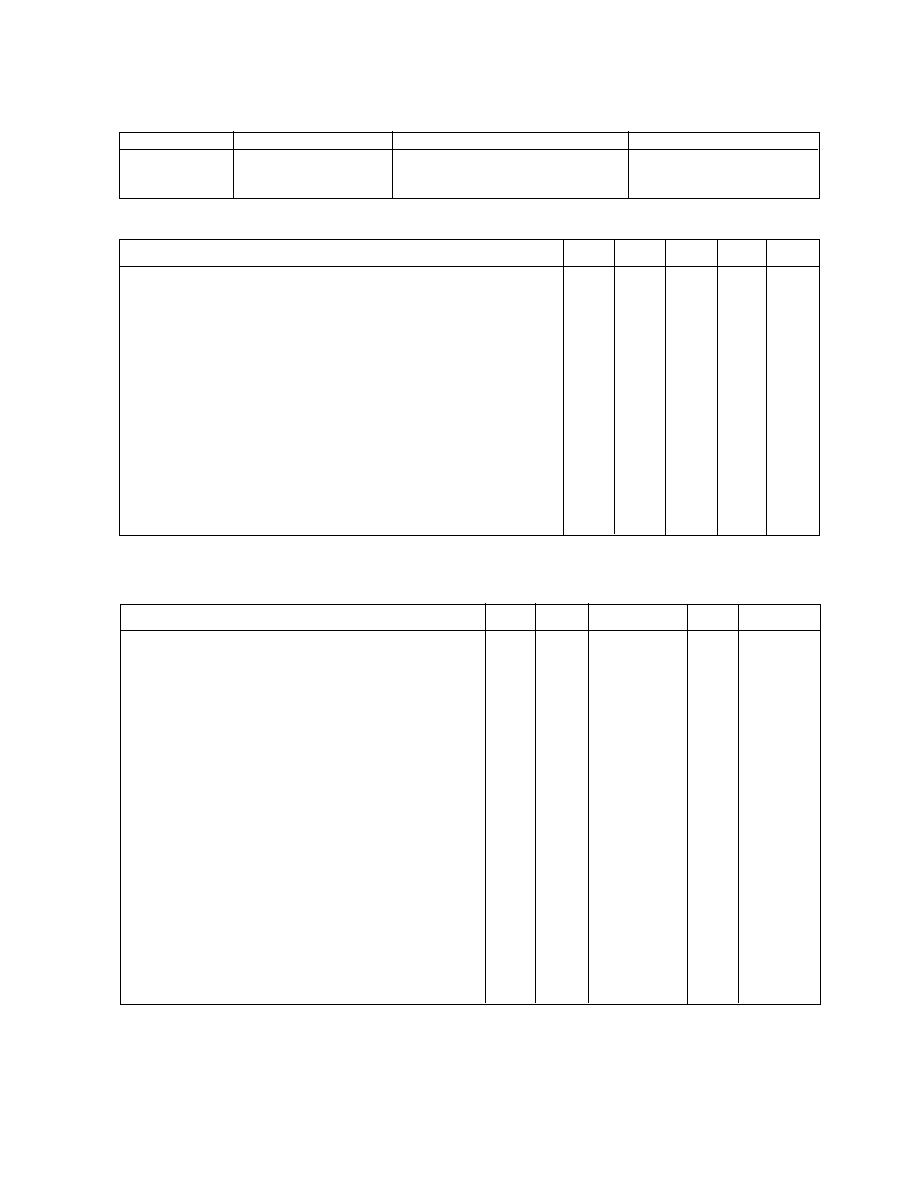
VP5313/VP5513
3
Pins
All pins
All pins
Notes
Meets Mil-Std-883 Class 2
Test Levels
2kV on 100pF through 1k5
200V on 200pF through 0
& 500nH
Test
Human body model
Machine model
Luminance bandwidth
Chrominance bandwidth (Extended B/w mode)
Chrominance bandwidth (Reduced B/w mode)
Burst frequency (NTSC)
Burst frequency (PAL-B, D,G,H,I)
Burst frequency (PAL-N Argentina)
Burst cycles (NTSC and PAL-N)
Burst cycles ( PAL-B, D, G, H,I)
Burst envelope rise / fall time (NTSC )
Burst envelope rise / fall time (PAL-B, D, G, H, I, N)
Analog video sync rise / fall time (NTSC)
Analog video sync rise / fall time (PAL-B, D, G, H,I)
Analog video blank rise / fall time (NTSC )
Analog video blank rise / fall time (PAL-B, D, G, H,I)
Differential gain
Differential phase
Signal to noise ratio (unmodulated ramp)
Chroma AM signal to noise ratio (100% red field)
Chroma PM signal to noise ratio (100% red field)
Hue accuracy
Colour saturation accuracy
Residual sub carrier
Luminance / chrominance delay
VIDEO CHARACTERISTICS (NTSC, PAL COMPOSITE VIDEO)
Parameter
1
1
-61
-56
-58
2.5
2.5
10
Max.
Symbol
Min.
Typ.
5.5
1.3
650
3.57954545
4.43361875
3.58205625
9
10
300
300
145
245
145
245
-60
5
MHz
MHz
kHz
MHz
MHz
MHz
Fsc cycles
Fsc cycles
ns
ns
ns
ns
ns
ns
% pk-pk
�
pk-pk
dB
dB
dB
%
%
dB
ns
Units
ESD COMPLIANCE
19.98
1.337
33.75
17.63
1.40
7.61
7.61
0.40
18.70
8.01
8.01
0.00
DC CHARACTERISTICS DACs
mA
mA
mA
mA
mA
mA
mA
mA
mA
mA
mA
mA
Parameter
Symbol
Min.
Typ.
Max.
Units
RGB outputs:
Peak level
Black level
CVBS1, 2 Y and C outputs - NTSC (pedestal enabled)
Maximum output, relative to sync bottom
White level relative to black level
Black level relative to blank level
Blank level relative to sync level
Colour burst peak - peak
DC offset (bottom of sync)
CVBS1, 2, Y and C outputs - PAL
White level relative to black level
Black level relative to sync level
Colour burst peak - peak
DC offset (bottom of sync)
All figures are for: RREF = 730
; if RL = 75
then RREF = 1460

VP5313/VP5513
4
Pin Name
Pin No.
Description
PD0-7
2-4,
8 Bit Pixel Data inputs clocked by PXCK. PD0 is the least significant bit. These pins are
internally pulled low.
PXCK
44
27MHz Pixel Clock input. The VP5313/VP5513 internally divides PXCK by two to provide the
pixel clock.
SA
18
Slave address select.
SCL
23
Standard I
2
C bus serial clock input.
SDA
24
Standard I
2
C bus serial data input/output.
FC0-2
12-14
Field Counter output in master sync mode.
REFSQ
9
Reference square wave input used only during Genlock mode.
SCSYNC
8
Subcarrier sync input, (synchronises phase quadrant in 4xfsc genlock mode), see fig 6.
PALID
7
PAL IDENT input, controls swinging colour burst phase in PAL genlock mode.
COMPSYNC
6
Composite sync pulse output. This is an active low output signal.
CLAMP
5
The CLAMP output signal is synchronised to COMPSYNC output and indicates the position of
the BURST pulse, (lines 10-263 and 273-525 for NTSC; lines 6-310 and 319-623 for PAL-
B,D,G,I,N(Argentina)).
TTXREQ
17
Teletext Data Request output, requests next line of teletext data.
TTXDATA
19
Teletext Data input.
HSYNC
15
Horizontal Sync, output in master mode, input in slave mode
VSYNC
16
Vertical Sync, output in master mode, input in slave mode
RESET
22
Master reset. This is an asynchronous, active low, input signal and must be asserted for a
minimum 200ns in order to reset the VP5313/VP5513.
VREF
33
Voltage reference output. This output is nominally 1�0V and should be decoupled with a
100nF capacitor to GND.
RREF
34
DAC full scale current control. A resistor connected between this pin and GND sets the
magnitude of the video output current. An internal loop amplifier controls a reference current
flowing through this resistor so that the voltage across it is equal to the Vref voltage. This
reference current has a weighting equal to 20.8 LSB's.
DACCOMP
25
DAC compensation. A 100nF ceramic capacitor must be connected to AVDD.
CVBS1
32
Composite video output. These are high impedance current source outputs. A DC path to
GND must exist from each of these pins.
BLUE/CVBS2
31
Blue or composite DAC output. Output type as CVBS1.
GREEN/Y
27
Green or luminance DAC output. Output type as CVBS1.
RED/C
26
Red or chrominance DAC output. Output type as CVBS1.
VDD
1, 11, 20
Positive supply input. All VDD pins must be connected.
AVDD
37,28,30
Analog positive supply input. All AVDD pins must be connected.
GND
10,21,43
Negative supply input. All GND pins must be connected.
AGND
36,29,35
Analog negative supply input. All AGND pins must be connected.
PIN DESCRIPTIONS
38-42

VP5313/VP5513
5
Figure 3 Glitch Energy (see Peak Glitch Energy in table on page 2)
Figure 2 Functional block diagram
The glitch energy is calculated by measuring the area under the voltage
time curve for any LSB step, typically specified in picoVolt-seconds (pV-s)
Peak Glitch Area = H x W/2
V
T(ps)
W
H
G/Y
9 BIT
DAC
B/CVBS2
9 BIT
DAC
R/C
9 BIT
DAC
CVBS1
9 BIT
DAC
MUX
+
+
CLOSED
CAPTION
ANTI-TAPING
CONTROL
SET-UP
REGISTERS
I
2
C INTERFACE
YCrCb to
RGB
YCrCb
Y
UV
TELETEXT
SHAPING
FILTER
TELETEXT
CONTROL
INPUT
DEMUX
INTERPOLATING
FILTERS
VIDEO TIMING GENERATOR
DIGITAL
PHASE COMP
COLOUR SUBCARRIER
GENERATOR
SYNC
INSERT
MODULATOR
REFSQ
SCSYNC
PALID
COMPSYNC
FC0-2
VSYNC
HSYNC
PXCK
PD7-0
TTXREQ
TTXDATA
RESETB
SA
SCL
SDA
CLAMP
8
YCrCb
YUV
3
DAC
REF
RREF
VREF
DACCOMP
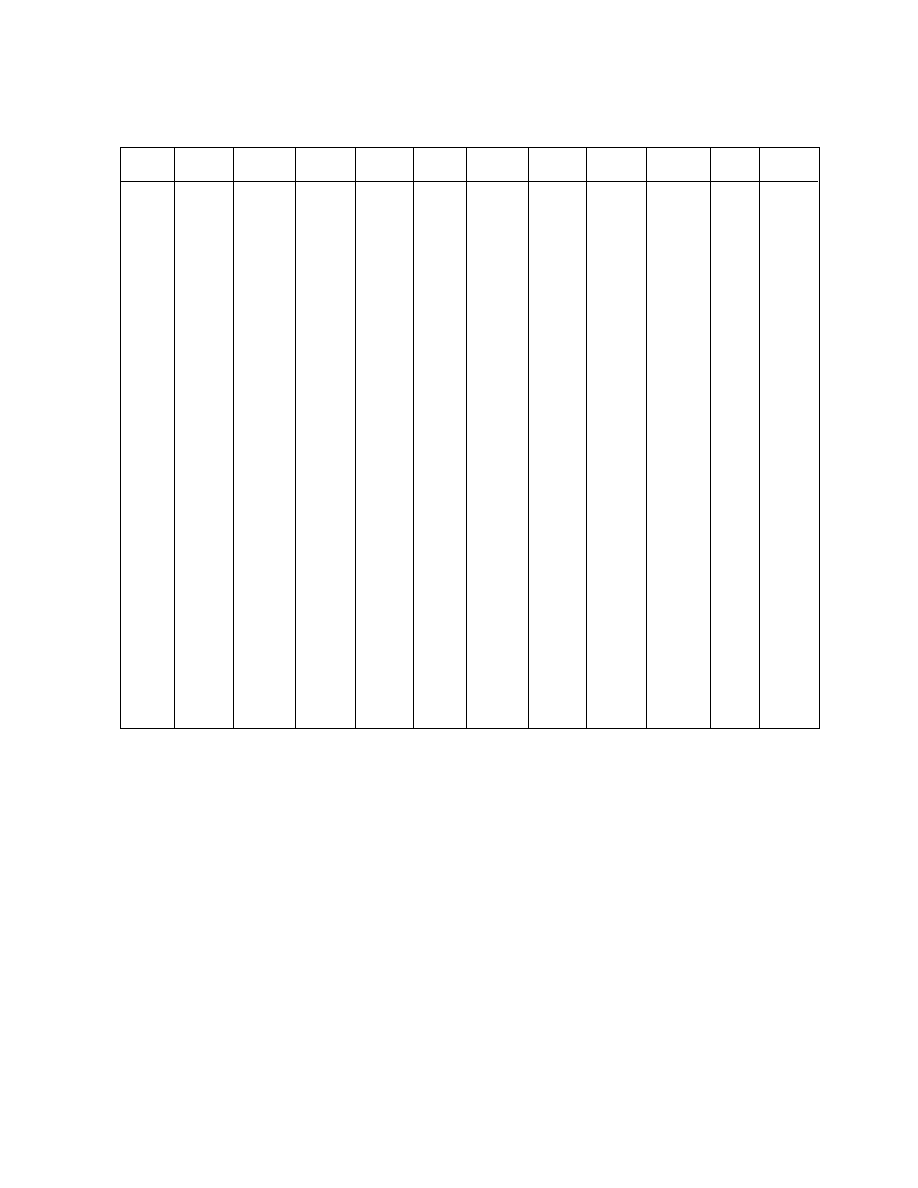
VP5313/VP5513
6
ADDRESS
hex
00
01
02
03
04
05
06
07
08
09
0A
0B
0C
0D
0E
0F
10
11
12
13-1F
20-33
34-3F
40
41
42
43
44
45
46
47
48-4F
50
51
52
53
54
55-5F
60
61
62-FD
FE-FF
REGISTER
NAME
BAR
PART ID2
PART ID1
PART ID0
REV ID
MODE
GCR
VOCR
RSTCTL
SC_ADJ
FREQ2
FREQ1
FREQ0
SCHPHM
SCHPHL
HSOFFL
HSOFFM
SLAVE1
SLAVE2
TSTPAT
Not used
Reserved
Not used
TTXLO2
TTXLO1
TTXLO0
TTXLE2
TTXLE1
TTXLE0
TTXDD
TTXCTL
Not used
CCREG1
CCREG2
CCREG3
CCREG4
CC_CTL
Not used
IICEXCTL
IICEXW/R
Not used
Reserved
7
RA7
ID17
ID0F
ID07
REV7
-
FSC4SEL
DITHEN
SC7
FR17
FR0F
FR07
-
SCH7
HSOFF7
-
NCORSTD
HCNT7
-
-
L14
L22
-
L327
L335
TTXDD7
-
-
-
-
-
CTL7
W/RD7
6
RA6
ID16
ID0E
ID06
REV6
-
GENDITH
CHRMCLIP
SC6
FR16
FR0E
FR06
-
SCH6
HSOFF6
-
VBITDIS
HCNT6
-
-
L13
L21
-
L326
L334
TTXDD6
F1W1D6
F1W2D6
F2W1D6
F2W2D6
-
CTL6
W/RD6
5
RA5
ID15
ID0D
ID05
REV5
-
GENLKEN
CHRBW
SC5
FR15
FR0D
FR05
-
SCH5
HSOFF5
-
VSMODE
HCNT5
-
-
L12
L20
-
L325
L333
TTXDD5
F1W1D5
F1W2D5
F2W1D5
F2W2D5
-
CTL5
W/RD5
4
RA4
ID14
ID0C
ID04
REV4
DACCFG
NOLOCK
SYNCDIS
SC4
FR14
FR0C
FR04
-
SCH4
HSOFF4
-
F_SWAP
HCNT4
-
-
L11
L19
-
L324
L332
TTXDD4
F1W1D4
F1W2D4
F2W1D4
F2W2D4
-
CTL4
W/RD4
2
RA2
ID12
ID0A
ID02
REV2
VFS0
YCDELAY
LUMDIS
SC2
FR12
FR0A
FR02
-
SCH2
HSOFF2
-
SL_HS0
HCNT2
-
-
L9
L17
-
L322
L330
TTXDD2
F1W1D2
F1W2D2
F2W1D2
F2W2D2
F1ST
CTL2
W/RD2
1
RA1
ID11
ID09
ID01
REV1
SYNCM1
CLMPDIS
CHRDIS
SC1
FR11
FR09
FR01
-
SCH1
HSOFF1
HSOFF9
HCNT9
HCNT1
TTXPAT
-
L8
L16
L319
L321
L329
TTXDD1
F1W1D1
F1W2D1
F2W1D1
F2W2D1
F2EN
CTL1
W/RD1
3
RA3
ID13
ID0B
ID03
REV3
VFS1
PALIDEN
BURDIS
SC3
FR13
FR0B
FR03
-
SCH3
HSOFF3
-
SL_HS1
HCNT3
-
-
L10
L18
-
L323
L331
TTXDD3
F1W1D3
F1W2D3
F2W1D3
F2W2D3
F2ST
CTL3
W/RD3
DEFAULT
hex
00
53
13
01
00
00
20
00
9C
A8
26
2B
00
00
7E
00
00
00
00
00
00
00
00
00
00
01
00
XX
XX
XX
XX
00
FF
-
0
RA0
ID10
ID08
ID00
REV0
SYNCM0
CVBSCLMP
PEDEN
TSURST
SC0
FR10
FR08
FR00
SCH8
SCH0
HSOFF0
HSOFF8
HCNT8
HCNT0
RAMPEN
L6
L7
L15
L318
L320
L328
TTXDD0
TTXEN
F1W1D3
F1W2D3
F2W1D3
F2W2D3
F1EN
CTL0
W/RD0
R/W
W
R
R
R
R
R/W
R/W
R/W
R/W
R/W
R/W
R/W
R/W
R/W
R/W
R/W
R/W
R/W
R/W
R/W
R/W
R/W
R/W
R/W
R/W
R/W
R/W
R/W
R/W
R/W
R/W
R/W
R/W
W
R/W
REGISTERS MAP
See Register Details for further explanations.
Table.1 Register map

VP5313/VP5513
7
REGISTER DETAILS
BAR
Base register
RA7-0
Register address
PART ID 2-0
Part number
ID17-00
Chip part ID number
REV ID
Revision number
REV7-0
Chip revision ID number
MODE
Mode Control
DACCFG
0
R,G,B & CVBS analog outputs
1
Y,C, CVBS1 & CVBS2 analog outputs
VFS1
VFS0
Video Standard
0
0
PAL-B,D,G,H,I,N(Arg.)
0
1
NTSC
1
0
Reserved
1
1
Reserved
SYNCM1 SYNCM0
Sync mode
0
0
Slave, Rec. 656
0
1
Slave H & V I/P
1
0
Master H & V O/P
1
1
Reserved
GCR
Global Control
FSC4SEL
Input subcarrier frequency select
0
REFSQ I/P = Fsubcarrier
SCSYNC I/P ignored
1
REFSQ I/P = 4 x Fsubcarrier
When SCSYNC I/P is asserted the
REFSQ I/P divide by 4 is reset
GENDITH
Genlock dither addition control
0
No dither added
1
Dither added
GENLKEN
Genlock enable control
0
Internal subcarrier generation
1
When high, enable Genlock to REFSQ
NOLOCK
Genlock status bit (read only)
0
Genlocked
1
Cannot lock to REFSQ.
This bit is cleared by reading and set
again if lock cannot be attained.
PALIDEN
PAL Ident select
0
Normal operation, internal PAL switch
is used.
1
Enables PALID input, a phase control
an for PALID signal, (0 = +135
�
, 1 = -135
�
)
YCDELAY
Add delay to luma channel
0
Luma to Chroma delay, 0ns
1
Luma to Chroma delay, 37ns
CLAMPDIS
CLAMP O/P select
0
CLAMP O/P enabled
1
CLAMP O/P disabled
CVBSCLAMP Composite clamp enable
0
CVBS Clamp disabled
1
Clamps CVBS output, to prevent out of
range DAC codes.
VOCR
Video Output Control
DITHEREN
Luma dither enable
0
Normal operation
1
Luma dither enabled
CHRMCLIP
Chroma clipping select
0
No chroma clipping
1
Enable clipping of chroma data when
luma is clipped
CHRBW
Chroma bandwidth select
0
�
650kHz
1
�
1�3MHz
SYNCDIS
Sync disable (in CVBS signal)
0
Normal operation
1
Sync disabled
(COMPSYNC O/P is not affected)
BURDIS
Chroma burst disable
0
Normal operation
1
Chroma burst disabled
LUMDIS
Luma input disable - force black level
0
Normal operation
1
Luma disabled
CHRDIS
Chroma input disable - force monochrome
0
Normal operation
1
Chroma disabled
PEDEN
Pedestal (set-up) select
Valid for NTSC
0
Pedestal disabled
1
7�5 IRE pedestal on lines
23-262 and 286-525

VP5313/VP5513
8
RSTCTL
Reset Data Control
TSURST
Soft reset control
0
Normal operation
1
Chip soft reset
SC_ADJ
Sub Carrier Adjust
SC7-0
Sub carrier frequency seed value.
FREQ2-0
Sub carrier frequency
FR17-00
24 bit Sub carrier frequency programmed via
I
2
C bus. FREQ3 is the MSB.
SCHPHM-L
Sub carrier phase offset
SCH8-0
9 bit Sub carrier phase relative to the 50%
point of the leading edge of the horizontal
part of composite sync. SCHPHM bit 0 is the
MSB.
HSOFFL-M
Horizontal Sync Output Offset
HSOFF9-0
This is a 10 bit number which allows the user
to offset the start of digital data input with
reference to the pulse HS.
SLAVE1-2
H & V Slave Mode Control
NCORSTD
NCO line reset disable
NCO is always reset at end of 4(8)
field sequence in NTSC(PAL) regardless
of the value of this control bit
0
NCO is reset every line in NTSC mode
1
NCO line reset is disabled
VBITDIS
Ignore REC656 V-bit select
0
REC656 V-bit will be decoded and the
line blanked accordingly
1
REC656 V-bit will be ignored
VSMODE
Select type of Vsync input
0
Standard Vsync I/P
1
Field even/odd Vsync I/P
F_SWAP
Invert field detect decision
0
Standard relationship applies
1
Inverted relationship applies
SL_HS(1:0)
Internal Hsync delay control
00
No internal delay
01
1 x 27MHz cycle delay
10
2 x 27MHz cycle delay
11
3 x 27MHz cycle delay
TSLAVE2
HCNT(9:0) - Internal H counter is reset to this
value on falling edge of Hsync input.
TSTPAT
Test Pattern Register
TTX_PAT
Teletext test pattern enable
0
Normal operation
1
Teletext test pattern enabled
RAMPEN
Modulated test ramp enable
0
Normal operation
1
Modulated test ramp enabled
TTXLO2-0
Teletext Odd Line Enable
L6-22
1 = Teletext Enabled on that line number
TTXLE2-0
Teletext Even Line Enable
L318-335
1 = Teletext Enabled on that line number
TTXDD7-0
Teletext Request Pulse Position
TTXCTL
Teletext Control
TTXEN
Teletext enable
0
Teletext disabled
1
Teletext enabled
CCREG1
Closed Caption register 1
F1W1D6-0
Field one (line 21), first data byte
CCREG2
Closed Caption register 2
F1W2D6-0
Field one (line 21), second data byte
CCREG3
Closed Caption register 3
F2W2D6-0
Field two (line 284), first data byte
CCREG4
Closed Caption register 4
F2W2D6-0
Field two (line 284), second data byte
CCCTL
Closed Caption control register
F1ST
Field one (line 21) status bit
0
New data has been loaded to CCREG1-2
1
Data has been encoded
F2ST
Field one (line 284) status bit
0
New data has been loaded to CCREG3-4
1
Data has been encoded
F1EN
Closed Caption field one (line 21)
0
Disabled
1
Enabled
F2EN
Closed Caption field one (line 284)
0
Disabled
1
Enabled
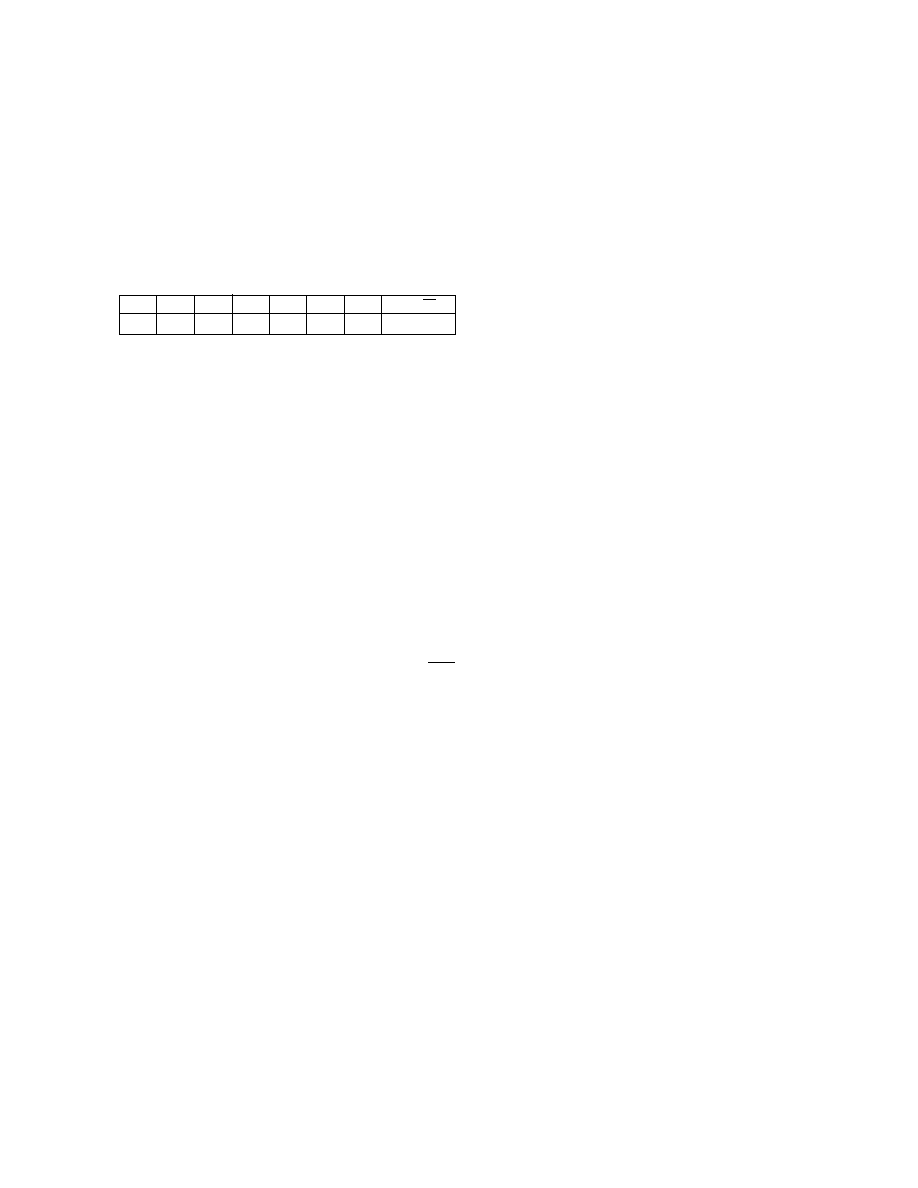
VP5313/VP5513
9
IICEXCTL
I
2
C Extension Control
CTL7-0
Each bit controls port direction
0 = output 1 = input
IICEXR/W
I
2
C Extension Control
RD7-0
I
2
C bus read and write data from
I
2
C extension port
I
2
C BUS CONTROL INTERFACE
I
2
C bus address
The serial microprocessor interface is via the bi-directional
port consisting of a data (SDA) and a clock (SCL) line. It is
compatible to the Philips I
2
C bus standard (Jan. 1992
publication number 9398 393 40011). The interface is a slave
transmitter - receiver with a sub-address capability. All
communication is controlled by the microprocessor. The SCL
line is input only. The most significant bit (MSB) is sent first.
Data must be stable during SCL high periods.
A bus free state is indicated by both SDA and SCL lines
being high. START of transmission is indicated by SDA being
pulled low while SCL is high. The end of transmission, referred
to as a STOP, is indicated by SDA going from low to high while
SCL is high. The STOP state can be omitted if a repeated
START is sent after the acknowledge bit. The reading device
acknowledges each byte by pulling the SDA line low on the
ninth clock pulse, after which the SDA line is released to allow
the transmitting device access to the bus.
The device address can be partially programmed by the
setting of the pin SA. This allows the device to respond to one
of two addresses, providing for system flexibility. The I
2
C bus
address is seven bits long with the last bit indicating read/write
for subsequent bytes.
The first data byte sent after the device address, is the sub-
address - BAR (base address register). The next byte will be
written to the register addressed by BAR and subsequent
bytes to the succeeding registers. The BAR maintains its data
after a STOP signal.
NTSC/PAL Video Standards
Both NTSC (4-field, 525 lines) and PAL (8-field, 625 lines)
video standards are supported by the VP5313/VP5513. All
raster synchronisation, colour sub-carrier and burst charac-
teristics are adapted to the standard selected. The VP5313/
VP5513 generates outputs which follow the requirements of
SMPTE 170M and CCIR 624 for PAL signals.
The device supports the following standards:
PAL B, D, G, H, I, N (Argentina) (default state) and
NTSC.
Video Blanking
The VP5313/VP5513 automatically performs standard
composite video blanking. Lines 1-9, 264-272 inclusive, as
well as the last half of line 263 are blanked in NTSC mode. In
PAL mode, lines 1-5, 311-318, 624-625 inclusive, as well as
the last half of line 623 are blanked.
A6
0
A5
0
A4
0
A3
1
A2
1
A0
SA
A1
0
R/
W
X
The V bit within REC656 defines the video blanking when
in TRS slave mode. By setting VBITDIS in the SLAVE1
register this blanking can be overidden. When in MASTER
mode the V bit is ignored; hence, if any lines are required to be
blank, they must have no video signal input on them.
Interpolator
The luminance and chrominance data is separately
passed through interpolating filters to produce output
sampling rates double that of the incoming pixel rate. This
reduces the sinx/x distortion that is inherent in the digital to
analog converters (DACs), and also simplifies the analog
reconstruction filter requirements.
Digital to Analog Converters
The VP5313/VP5513 contains four 9 bit digital to analog
converters which produce the analog video signals. The
DACs use a current steering architecture in which bit currents
are routed to one of two outputs; thus the DAC has true and
complimentary outputs, however, only the true outputs are
available on the pins. The use of identical current sources and
current steering their outputs means that monoticity is
guaranteed. An on-chip voltage reference of 1�00V (typ.)
provides the necessary biasing; if required, this can be
overridden by an external reference.
The full-scale output currents of the DACs is set by an
external 730
resistor between the RREF and AGND pins. An
on-chip loop amplifier stabilises the full-scale output current
against temperature and power supply variations.
By digitally summing the luma and chroma outputs a
composite output is generated. The analog outputs of the
VP5313/VP5513 are capable of directly driving doubly
terminated 75
co-axial cable. If it is required only to drive a
single 75
load then the DACGAIN resistor is simply doubled.
Luminance, Chrominance and Composite Video Outputs
The Luminance video output drives a 37.5
load at 1�0V,
sync tip to peak white. It contains only the luminance content
of the image plus the composite sync pulses. In the NTSC
mode, a set-up level offset is added during the active video
portion of the raster.
The Chrominance video output drives a 37.5
load at
levels proportional in amplitude to the luma output (40 IRE pk-
pk burst). Burst is injected with the appropriate timing relative
to the luma signal.
Output sinx/x compensation filters are required on all
video outputs, as shown in the typical application diagram, see
fig. 11 & 12.
RGB Video Outputs
The RGB video outputs drive a 37.5
load at 0.7V blank
to peak.
Output sinx/x compensation filters are required on all
video outputs, as shown in the typical application diagram, see
fig. 11 & 12.
Video Timing - Slave sync mode
The VP5313/VP5513 has an internal timing generator
which produces video timing signals appropriate to the mode
of operation. TRS slave mode means that the video encoder
synchronises itself to the TRS (Timing Reference Signal)
codes that are embedded into the Rec. 656 data pattern. In the

VP5313/VP5513
10
default (power up) the TRS slave mode is selected. All internal
timing signals are derived from the input clock, (PXCK) this
must be derived from a crystal controlled oscillator. Input pixel
data is latched on the rising edge of the PXCK clock.
The video timing generator produces the internal blanking and
burst gate pulses, together with the composite sync output
signal.
H&V slave mode is enabled by setting the SYNCM1-0 bits
in the MODE register to 01. In this mode the position of the
video syncs is derived from the HS and VS inputs. These HS
and VS pins are automatically configured as inputs.
Video Timing - Master sync mode
When SYNCM1-0 of the MODE register are 10, the
VP5313/VP5513 operates in a MASTER sync mode, all
REC656 timing reference codes are ignored with VS, HS and
FC0-2 outputs providing synchronisation signals to an
external (MPEG) device. The PXCK signal is, however, still
used to generate all internal clocks. In master mode the
direction setting of bits 4 - 0 of the IICEXCTL register are
ignored.
VS is the start of the field sync datum in the middle of the
equalisation pulses. HS is the line sync which is used by the
preceding MPEG2 decoder to define when to output digital
video data to the VP5313/VP5513. The position of the falling
edge of HS relative to the first data Cb0, can be programmed
in HSOFFM-L registers, see figure 5.
Genlock using REFSQ input
The VP5313/VP5513 can be Genlocked to another video
source by setting GENLKEN high (in GCR register) and
feeding a phase coherent sub carrier frequency signal into
REFSQ. Under normal circumstances, REFSQ will be the
same frequency as the sub carrier; however if FSC4SEL is set
high (in GCR register), a 4 x sub carrier frequency signal may
be input to REFSQ. In this case, the Genlock circuit can be
reset to the required phase of REFSQ, by supplying a pulse
to SCSYNC. The frequency of SCSYNC can be at the sub
carrier frequency, once per line or once per field could be
adequate, depending on the application. When GENLKEN is
set high, the direction setting of bit 5 of the IICEXCTL register
is ignored.
PALID input
When using PAL and Genlock mode; the VP5313/VP5513
requires a PAL phase identification signal, to define the
correct phase on every line. This is supplied to PALID input,
High = -135
�
and low = +135
�
. The signal is asynchronous,
and should by changed before the sub carrier burst signal.
PALID input is enabled by setting PALIDEN high (in GCR
register). When PALIDEN is set high, the direction setting of
bit 7 of the IICEXCTL register is ignored.
Line 21 coding
Two bytes of data are coded on the line 21 of each field,
see figure 8. In the NTSC Closed Caption service, the default
state is to code on line 21 of field one only. An additional
service can also be provided using line 21 (284) of the second
field. The data is coded as NRZ with odd parity, after a clock
run-in and framing code. The clock run-in frequency =
0.5034965MHz which is related to the nominal line period, D
= H / 32.
D = 63.55555556 / 32
�
s
Two data bytes per field are loaded via I
2
C bus registers
CCREG1-4. Each field can be independently enabled by
programming the enable bits in the control register (CC_CTL).
The data is cleared to zero in the Closed Caption shift
registers after it has been encoded by the VP5313/VP5513.
Two status bit are provided (in CC_CTL), which are set high
when data is written to the registers and set low when the data
has been encoded on the Luma signal. The data is cleared to
zero in the Closed Caption shift registers after it has been
encoded by the VP5313/VP5513. The next data bytes must
be written to the registers when the status bit goes high,
otherwise the Closed Caption data output will contain Null
characters. If a transmission slot is missed (ie. no data
received) the encoder will send Null characters. Null
characters are invisible to a closed caption reciever. The MSB
(bit 7) is the parity bit and is automatically added by the
encoder.
Teletext
The Teletext function within the VP5313/VP5513 co-
ordinates the insertion of teletext serial data into the
luminance data stream and subsequently the composite video
data stream.
The serial data is filtered prior to insertion to minimise the
high frequency components and to reduce the jitter inherent in
the digital data stream.
The lines in which teletext data are inserted are individually
programmable for both even and odd fields. The insertion of
teletext data will only be enabled if the format of the composite
video is configured to be PAL-B,G,H,I,N and the teletext
enable bit TTXEN is asserted.
For test purposes, the teletext function incorporates
control logic to generate a serial clock cracker pattern in place
of the normal teletext data. This test pattern is enabled when
the TTX_PAT bit is asserted. There is no row coding used so
it will not display on a TV.
The VP5313/VP5513 teletext interface comprises of a
teletext request output, TTX_REQ, and a serial data input,
TTX_DATA.
To ensure that the composite video timing requirements
are satisfied, the serial data must be received at a specific
point in time during lines containing teletext data. The teletext
request output, TTX_REQ, will be asserted to indicate when
data must be applied to TTX_DATA, which must be generated
synchronous to the rising edges of PXCK. The TTX_REQ may
be advanced in multiples of PXCK, to compensate for the
latency within the source device, by writing to the TTXDD
register.
The serial teletext data which is applied to the TTX_DATA
input must obey the sequence defined below.
The teletext bit rate is defined to be 6.9375 MHz, which
equates to 444 times the PAL line frequency (15.625 kHz). It
is clear that for a 27 MHz system clock, a constant bit period
cannot be achieved.

VP5313/VP5513
11
Figure 5 REC 656 interface with HS output timing
Pixel Data Input (PD[7,0])
PXCK Input (27MHz)
Cb0
Cr0
Y0
Y1
Y2
Y3
Cb1
Cr1
HS
Nck=0
Nck=2
t
SU; PD
t
HD; PD
The horizontal line duration for PAL equates to 1728
CLK27M cycles and within each line there are 444 data bit
periods. The duration of 37 data bits (the smallest number
possible for an integer number of CLK27M cycles) therefore
equates to 144 CLK27M cycles.
To ensure that the average bit rate is 6.9375 MHz, 33 in
every 37 data bits will have a duration of 4 CLK27M cycles and
4 in every 37 data bits will have a duration of 3 CLK27M cycles.
Of the first 37 data bits in each line, bits 10, 19, 28 and 37 will
have a duration of 3 CLK27M cycles. The sequence will be
repeated for all subsequent 37 bit groups.
Master Reset
The VP5313/VP5513 must be initialised with RESET. This
is an asynchronous, active low signal and must be active for
a minimum of 200ns in order to reset the VP5313/VP5513.
The device resets to line 64, start of horizontal sync (i.e. line
blanking active). There is no on-chip power on reset circuitry.
(d) = default
xx = don't care.
The calculation of the FREQ register value is according to the following formula:-
FREQ = 2
26
x
f
SC
/PXCK hex, where PXCK = 27.00MHz
NTSC value is rounded UP from the decimal number. PAL-B, D, G, H, I and N (Argentina) are rounded DOWN. The SC_ADJ
value is derived from the adjustment needed to be added after 8 fields to ensure accuracy of the Subcarrier frequency. Note the
SC_ADJ value of 9C required for PAL-B, D, G, H, I.
Standard
NTSC
PAL-B, G, H, I (d)
PAL-N (Argentina)
FREQ2-0
registers hex
87 C1 F1
A8 26 2B
87 DA 51
Lines/
field
525
625
625
Field
freq. HZ
59.94
50
50
1716
1728
1728
Number of
pixels/line
at 27MHz
15.734266
15.625000
15.625000
Horizontal
freq. kHz.
f
H
3.57954545
4.43361875
3.58205625
Subcarrier
freq. kHz.
f
SC
(455/2)
(1135/4+1/625)
(917/4+1/625)
f
SC
/f
H
SC_ADJ
register
hex
xx
9C
57
Table.2 Line, field and subcarrier standards and register settings
NCO Adjustment
1
2
3
4
5
6
7
8
9 10 11 12 13 14 15 16
18
17
19 20 21
22 23 24
4
3
4
4
3
4
TTXDD
textbit #:
TTX_REQ
TTX_DATA
CVBS/Y
Figure 4 Teletext timing diagram

VP5313/VP5513
12
Figure 6 REFSQ and SC_SYNC input timing
Figure 7 PAL_ID input timing
REFSQ
SC_SYNC
Q
t
SU; SC_SYNC
t
HD; SC_SYNC
1/ f
SC_SYNC
t
PWH; SC_SYNC
Divide by 4
Synchronous
Counter
RESET
REFSQ
SC_SYNC
2:1 mux
Q
FSC4_SEL
f
SC
1
0
Input to
Genlocking
Block
(register bit)
1439 1440 1441 1442 1443 1444 1445 1446 1447 1448 1449 1450
Y719 $FF
$00
$XY
$00
EAV SEQUENCE
ANCILLARY DATA...
Pixel Data Input (PD[7,0\)
Sample Number
PAL_ID Stable
Input (PAL_ID)
PXCK Input (27MHz)
t
PWH; PXCK
t
PWL; PXCK
t
SU; PD
t
HD; PD
t
HD; PAL_ID
t
SU; PAL_ID
t
DUR; PAL_ID

VP5313/VP5513
13
TIMING INFORMATION
Min.
Typ.
10
14.5
10
5
10
0
10
0
9
27.0
Max.
TBD
TBD
25
Units
MHz
ns
ns
ns
ns
ns
ns
ns
ns
ns
ns
PXCK
periods
ns
f
PXCK
t
PWH
;
PXCK
t
PWL
;
PXCK
t
RP
t
FP
t
SU;PD
t
HD;PD
t
SU;SC_SYNC
t
HD;SC_SYNC
t
SU;PAL_ID
t
HD;PAL_ID
t
DUR;PAL_ID
t
DOS
10% to 90% points
90% to 10% points
PXCK to COMPSYNC
PXCK to CLAMP
Conditions
Parameters
Master clock frequency (PXCK input)
PXCK pulse width, HIGH
PXCK pulse width, LOW
PXCK rise time
PXCK fall time
PD7-0 set up time
PD7-0 hold time
SCSYNC set up time
SCSYNC hold time
PALID set up time
PALID hold time
PALID duration
Output delay
Symbol
Note: Timing reference points are at the 50% level. Digital C
LOAD
<40pF.
Figure 8 Closed Capation format
BIT0 BIT1 BIT2 BIT3 BIT4 BIT5 BIT6 BIT7 BIT0 BIT1 BIT2 BIT3 BIT4 BIT5 BIT6 BIT7
1
CLOCK RUN-IN
START BITS
13
DATA BYTE 1
DATA BYTE 2
0 1 0 0 0 0 1 1
FRAME CODE
B
C
D
E
A
H
0
50
-40
IRE
HSYNC COLOUR BURST
S1 S2 S3
P
P
P = Parity Bit
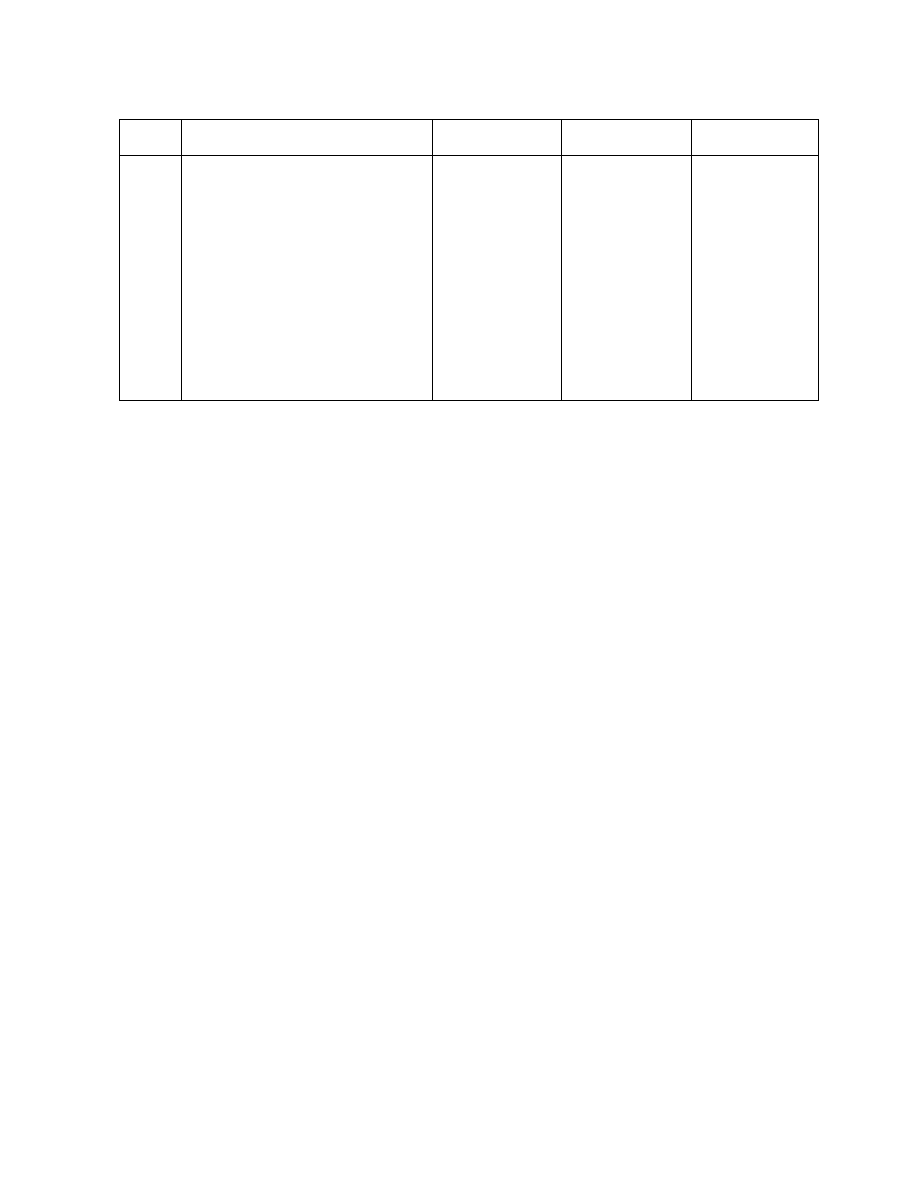
VP5313/VP5513
14
10.250
�
s
48 IRE
10.500
�
s
6.5D (12.910
�
s)
2.0D (3.972
�
s)
1.0D (1.986
�
s)
16.0D (31.778
�
s)
32.0D (63.556)
0.240
�
s
50 IRE
0 IRE
0 IRE
48 IRE
50 IRE
10.750
�
s
0.288
�
s
52 IRE
2 IRE
52 IRE
Encoder minimum
Encoder nominal
Encoder maximum
Description
H-sync to clock run-in
Clock run-in
2, 3
Clock run-in to third start bit
3
Data bit
1, 3
Data characters
4
Horizontal line
1
Rise / fall time of data bit transitions
5
Data bit high (logic level one)
6
Clock run-in maximum
Data bit low (logic level zero)
6
Clock run-in minimum
Data bit differential (high - low)
Clock run-in differential (max. - min)
Interval
A
B
C
D
E
H
Table. 5 Closed Caption data timing. (source EIA R - 4.3 Sept 16 1992)
Notes
1.
The Horizontal line frequency fH is nominally 15734.26Hz
�
0.05Hz. Interval D shall be adjusted to D = 1/(fH x 32) for the
instantaneous fH at line 21.
2.
The clock run-in signal consists of 7.0 cycles of a 0.5034965MHz (1/D) sine wave when measured from the leading to trailing
0 IRE points. The sine wave is to be symmetrical about the 25 IRE level.
3.
The negative going midpoints (half amplitude) of the clock run-in shall be coherent with the midpoints (half amplitude) of the
Start and Data bit transitions.
4.
Two characters, each consisting of 7 data bits and 1 odd parity bit.
5.
2 T Bar, measured between the 10% and 90% amplitude points.
6.
The clock run-in maximum level shall not differ from the data bit high level by more than
�
1 IRE. The clock run-in minimum
level shall not differ from the data bit low level by more than
�
1 IRE.
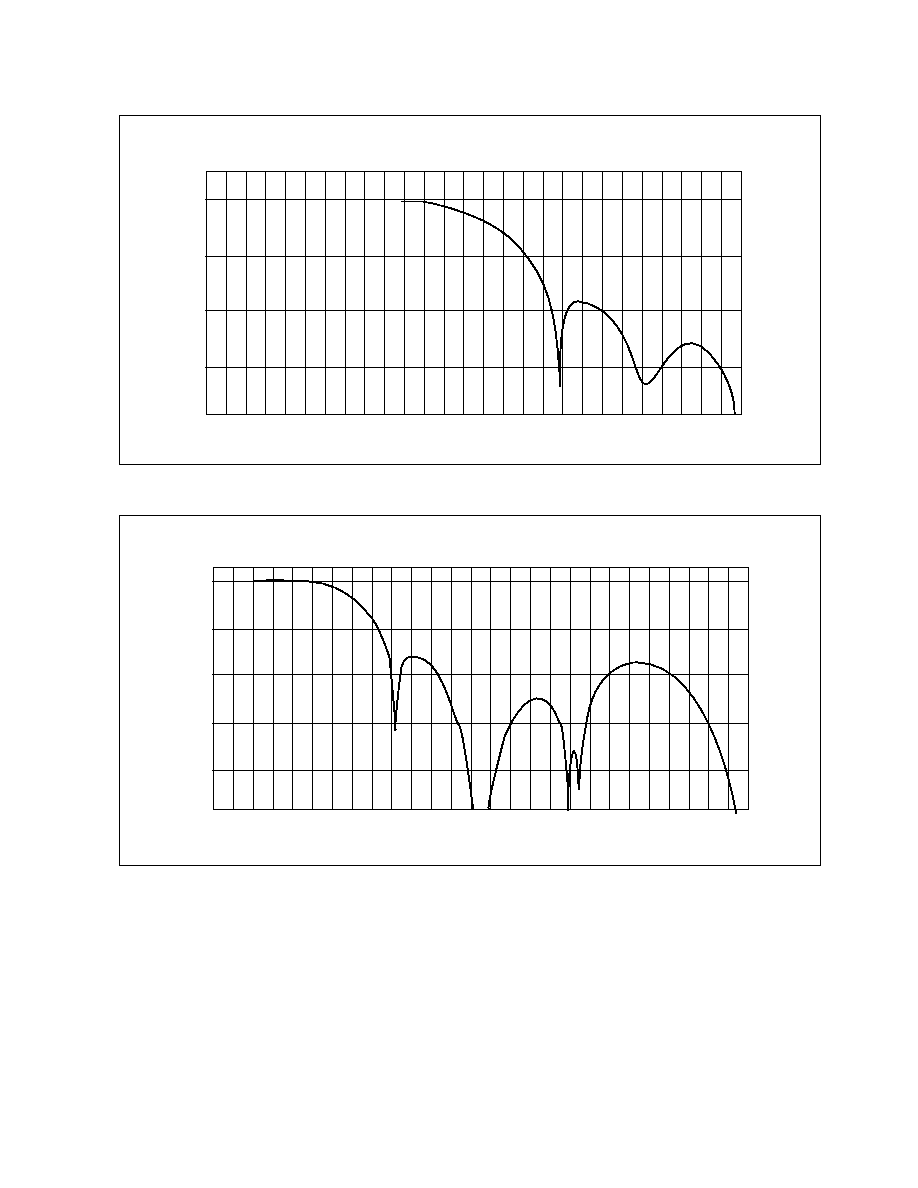
VP5313/VP5513
15
Figure 9 Luma filter for RGB datapath
Figure 10 Chroma filter for RGB datapath
0
-20
-40
-60
0
0
2.5e+6
5e+6
7.5e+6
10e+6
12e+6
0
2.5e+6
5e+6
7.5e+6
10e+6
12e+6
M
a
g
n
i
t
u
d
e
d
B
Frequency in Hz
Frequency Response Luma in RGB Path
0
-20
-40
-60
-80
0
0
2.5e+6
5e+6
7.5e+6
10e+6
12e+6
0
2.5e+6
5e+6
7.5e+6
10e+6
12e+6
M
a
g
n
i
t
u
d
e
d
B
Frequency in Hz
Frequency Response of Cr and Cb in RGB Path

VP5313/VP5513
16
Figure 11 Typical application diagram. (Output filter - see Fig.12)
to drive 37.5ohms
Figure 12 Output reconstruction filter
470pF
220pF
1.0
�
H
GND
75
15pF
EXT
75
+5V
SCL
SDA
SA
I
2
C
BUS
100
�
F
VDD, AVDD
GND, AGND
2k2
G/Y
8
PD0-7
TTXDATA
PXCK
2k2
B/CVBS2
R/C
CVBS1
RREF
VREF
DAC
COMP
SYNC
INTERFACE
HS
VS
SYSTEM
CLOCK
VDD
GND
10nF
GND
SCL
SDA
SA
RESET
RESET
TELETEXT
DIGITAL
VIDEO
GREEN/LUMA
TTXREQ
INTERFACE
OUTPUT
FILTER
BLUE/CVBS
OUTPUT
FILTER
RED/CHROMA
OUTPUT
FILTER
CVBS
OUTPUT
FILTER
AT EVERY
VDD PIN
FERRITE
BEAD
100nF
+5V
730
100nF

VP5313/VP5513
17
Note:
The VP5313 is only available to customers with a valid and existing authorisation to purchase issued by MACROVISION
CORPORATION.
This device is protected by U.S. patent numbers 4631603, 4577216 and 4819098 and other intellectual property rights. Use of
the Macrovision anticopy process in the device is licensed by Macrovision for non-commercial, home and limited exhibition uses
only. Reverse engineering or disassembly is prohibited.


M Mitel (design) and ST-BUS are registered trademarks of MITEL Corporation
Mitel Semiconductor is an ISO 9001 Registered Company
Copyright 1999 MITEL Corporation
All Rights Reserved
Printed in CANADA
TECHNICAL DOCUMENTATION - NOT FOR RESALE
World Headquarters - Canada
Tel: +1 (613) 592 2122
Fax: +1 (613) 592 6909
North America
Asia/Pacific
Europe, Middle East,
Tel: +1 (770) 486 0194
Tel: +65 333 6193
and Africa (EMEA)
Fax: +1 (770) 631 8213
Fax: +65 333 6192
Tel: +44 (0) 1793 518528
Fax: +44 (0) 1793 518581
http://www.mitelsemi.com
Information relating to products and services furnished herein by Mitel Corporation or its subsidiaries (collectively "Mitel") is believed to be reliable. However, Mitel assumes no
liability for errors that may appear in this publication, or for liability otherwise arising from the application or use of any such information, product or service or for any infringement of
patents or other intellectual property rights owned by third parties which may result from such application or use. Neither the supply of such information or purchase of product or
service conveys any license, either express or implied, under patents or other intellectual property rights owned by Mitel or licensed from third parties by Mitel, whatsoever.
Purchasers of products are also hereby notified that the use of product in certain ways or in combination with Mitel, or non-Mitel furnished goods or services may infringe patents or
other intellectual property rights owned by Mitel.
This publication is issued to provide information only and (unless agreed by Mitel in writing) may not be used, applied or reproduced for any purpose nor form part of any order or
contract nor to be regarded as a representation relating to the products or services concerned. The products, their specifications, services and other information appearing in this
publication are subject to change by Mitel without notice. No warranty or guarantee express or implied is made regarding the capability, performance or suitability of any product or
service. Information concerning possible methods of use is provided as a guide only and does not constitute any guarantee that such methods of use will be satisfactory in a specific
piece of equipment. It is the user's responsibility to fully determine the performance and suitability of any equipment using such information and to ensure that any publication or
data used is up to date and has not been superseded. Manufacturing does not necessarily include testing of all functions or parameters. These products are not suitable for use in
any medical products whose failure to perform may result in significant injury or death to the user. All products and materials are sold and services provided subject to Mitel's
conditions of sale which are available on request.


















